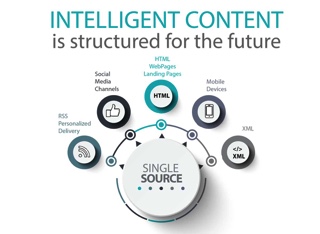 Guest Post by Kathy Vaské
Guest Post by Kathy Vaské
Intelligent content aka structured content is breaking out of its traditional boundaries. No longer is it used solely for product catalogs, technical specifications and the like.
Today, organizations are looking to use Structured Content for their ebooks, case studies, research reports and blogs. Why?
With the dynamic and ever-growing number of ways to consume content, there is a need to structure as much of our “valuable” content so it’s free to be automatically discovered and reused across multiple channels and devices and in a variety of previously impossible contexts.
A piece of “intelligent” content can be created once and served up in many places automatically e.g., blog article served up on an Apple Watch or Google Home. Now that’s intelligence.
What is Intelligent Content?
Intelligent content is essentially structured content. Structuring your content enables customers to find your message more easily online and employees to redeploy it more efficiently into multiple formats and media types.
More specifically, structured content is a way of organizing, storing and managing content, breaking it down into easily identifiable modules and then assigning/using metadata tags and automation to publish this intelligent content from a single source to multiple distribution channels.
According to Natalya Minkovsky of the Content Marketing Institute, “intelligent content is a technology-agnostic way of organizing and tagging content in consistent, predictable ways. Think of it as a way of enabling people and systems to take advantage of patterns across a body of content, making it easier to find, mix and match, and redeploy content components at a moment’s notice to any device, channel, or format.”
And, as content strategist Rachel Lovinger explains in a report for Razorfish, “Simply put, digital content needs to be free to go where and when people want it most. The more structure you put into content the freer it will become.”
It sounds like a lot of work involving a lot of people.
So why should you consider changing up your content strategy?
There are three trends driving the need for intelligent content to come to ebooks, reports, blogs, case studies, podcasts and more.
Three Driving Forces for Intelligent Content
- The speed of change in content consumption;
- The need for omnichannel ready content; and
- The need for Bot-Readable Content.
So, yeah, these have been around for a while, and though, their influence is gaining speed and it’s anyone’s guess as to how many and which kinds of devices your readers will use in the future. And c’mon, you’re lying if you say you know where and on what device your audience is going to search for and request to consume your content – and you want it to be consumed, right?
Now imagine it’s two years later or longer. If your content is to be viable in the longer term you want your creative work to be found whether it be delivered via voice on a Google Home device, on an Apple Watch or on a starship view screen.
With the dynamic and ever-growing number of ways to consume content, there is a need to structure as much of your “valuable” content so it is free to be automatically discovered and reused across multiple channels and devices and in a variety of previously impossible contexts. A piece of “intelligent” content can be created once and served up in many places automatically, for example, a blog article can be served up on an Apple Watch or Google Home. Now that’s intelligent.
Not enough to convince you?
Here are five benefits to structured content that might change your mind:
5 Top Benefits of Structured “Intelligent” Content:
1. Reuse Content, Reduce Duplication
Have you ever had to write something that you just knew had been written before … but no one could put his or her hands on it in time for you to use it? Frustrating. With structured content, you can quickly find, update, reuse already approved messaging and build from there. This saves time and eliminates a lot of duplicated effort.
2. Accuracy and Integrity, Easy Updating
Generating content centrally makes it easier to maintain and keep the content current. If using a component content management system (CCMS) you update in one place and with automation, all published material that pulls that content will be updated. Content accuracy and consistency is greatly improved.
3. Streamline the Publishing Process
When content is created in discrete modules or “chunks” in a CCMS and tagged, the metadata tags greatly streamline publishing material in different formats, to different channels and on different devices.
4. Simplify Translations
Translating entire documents is cumbersome and time-consuming. Translating modules of content is much more efficient, saving a tremendous amount of time and money.
5. Search Made Simple
When researching, it is difficult and can be time-consuming to find that specific piece of content that’s in a document (text, table, graphic, etc.). Tagging your content gives it context and makes it much easier for users to find the material they need – both internally and externally.
So are you ready to consider implementing an Intelligent Content Strategy?
You have to decide based on your content and your business goals.
It’s early yet.
Something I noted when researching for this article; it appears we’re in the beginning stages of structuring our non-technical content, because it’s not easy, it’s not one-size-fits-all and it’s not already been done by many organizations. So, if you want to one-up the competition, maybe you should be the first to structure some of your more compelling content and see what happens!
Here are some more articles to help you along the way:
Structured Content: Get Started with Content Models
Getting Started With Structured Content
3 Reasons You Need Structured Content Now
What is Structured Content? Definition, Benefits and How to Get Started
You don’t have to go all out and start some big complicated project. Take it on in manageable “chunks.” Start small, but start with the most valuable content and let us know how it goes in the comments below!
Image used with permission from Kathy Vaské
 Kathy Vaské is a Digital Marketing Strategist and Owner of Vaské Marketing Group. For over 20 years Kathy has led the marketing departments for corporate, mid-size and small businesses. Today, she is setting a new standard for delivering high-ROI consistency in marketing. Her commitment to streamlining and optimizing new business development systems is born from her own experiences with half-baked processes in both corporate and small business settings. Kathy specializes in bringing clarity and control to the marketing function. She helps clients develop marketing systems and processes that deliver not only new leads but connection and engagement between departments. Kathy’s company and website are currently in start-up mode but you can connect with her via Twitter @kvaske or LinkedIn.
Kathy Vaské is a Digital Marketing Strategist and Owner of Vaské Marketing Group. For over 20 years Kathy has led the marketing departments for corporate, mid-size and small businesses. Today, she is setting a new standard for delivering high-ROI consistency in marketing. Her commitment to streamlining and optimizing new business development systems is born from her own experiences with half-baked processes in both corporate and small business settings. Kathy specializes in bringing clarity and control to the marketing function. She helps clients develop marketing systems and processes that deliver not only new leads but connection and engagement between departments. Kathy’s company and website are currently in start-up mode but you can connect with her via Twitter @kvaske or LinkedIn.









Thank you, Kathy, for this excellent explanation. Now I know it’s time to get started. On to your links! Betsy
You are welcome, Betsy! Now is the time! This is a great opportunity for small and medium-sized businesses to get ahead of their larger competitors who may find it daunting to structure all their legacy content. And a note to them if they’re reading – don’t even try. Just start small and move forward.